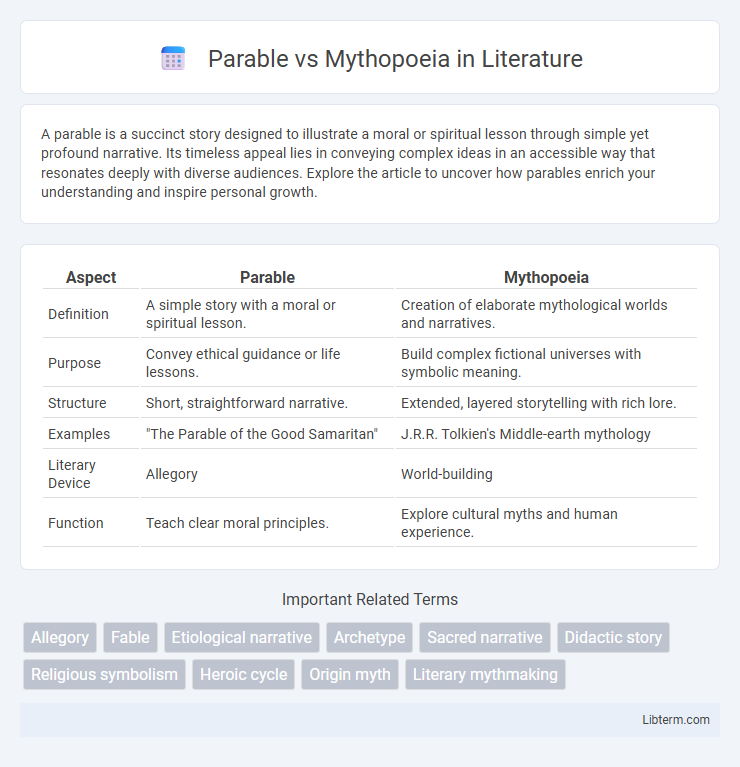A parable is a succinct story designed to illustrate a moral or spiritual lesson through simple yet profound narrative. Its timeless appeal lies in conveying complex ideas in an accessible way that resonates deeply with diverse audiences. Explore the article to uncover how parables enrich your understanding and inspire personal growth.
Table of Comparison
| Aspect | Parable | Mythopoeia |
|---|---|---|
| Definition | A simple story with a moral or spiritual lesson. | Creation of elaborate mythological worlds and narratives. |
| Purpose | Convey ethical guidance or life lessons. | Build complex fictional universes with symbolic meaning. |
| Structure | Short, straightforward narrative. | Extended, layered storytelling with rich lore. |
| Examples | "The Parable of the Good Samaritan" | J.R.R. Tolkien's Middle-earth mythology |
| Literary Device | Allegory | World-building |
| Function | Teach clear moral principles. | Explore cultural myths and human experience. |
Defining Parable: Core Features and Purpose
Parable is a concise narrative that conveys moral or spiritual lessons through relatable, real-world scenarios, often featuring human characters facing ethical dilemmas. Its core features include simplicity, clarity, and a direct message aimed at prompting reflection and ethical insight. Unlike mythopoeia, which constructs elaborate mythologies, parables emphasize practical wisdom and immediate applicability in everyday life.
Exploring Mythopoeia: Meaning and Significance
Mythopoeia refers to the creative process of crafting entire mythologies or fictional universes with complex narratives and symbolic meaning, often seen in works by authors like J.R.R. Tolkien. Unlike parables, which deliver clear moral lessons through simple stories, mythopoeia constructs immersive worlds that explore deep cultural, spiritual, and existential themes. This narrative form enriches literature and culture by providing a shared mythic framework that resonates with universal human experiences.
Historical Origins of Parables and Mythopoeia
Parables trace their historical origins to ancient oral traditions, prominently within Jewish and Christian scriptures, where succinct stories conveyed moral or spiritual lessons. Mythopoeia emerged from early myth-making cultures, including Indo-European and Near Eastern civilizations, creating complex narratives to explain natural phenomena and human experience through gods and heroes. Both forms serve as foundational storytelling methods but differ in scope, with parables focusing on ethical teaching and mythopoeia on mythic world-building.
Narrative Structures: Parable vs. Mythopoeia
Parables utilize concise, straightforward narrative structures centered on delivering moral or spiritual lessons through symbolic characters and situations, often culminating in a clear, singular message. Mythopoeia constructs expansive, complex narrative worlds rich in archetypes, cosmologies, and multifaceted characters that explore cultural origins, existential themes, and collective identity. The parable's simplicity aims for immediate interpretation, whereas mythopoeia invites ongoing exploration and layered understanding within an imaginative mythic framework.
Symbolism and Allegory: A Comparative Analysis
Parables utilize direct symbolism and straightforward allegory to convey explicit moral or spiritual lessons, often rooted in religious or cultural traditions. Mythopoeia employs complex, layered symbolism to construct entire mythological worlds, blending allegory with creation narratives that reflect collective archetypes and existential themes. This contrast highlights parables' focus on clarity and instruction versus mythopoeia's emphasis on mythic depth and narrative complexity.
Moral and Philosophical Lessons: Contrasts and Similarities
Parables convey explicit moral and philosophical lessons through simple narratives designed to teach ethical behavior or spiritual truths, often found in religious or cultural contexts such as the biblical parables of Jesus. Mythopoeia, or myth-making, creates intricate mythological worlds that embody complex philosophical ideas and cultural values, offering multi-layered interpretations rather than direct moral instruction. Both forms engage audiences in reflective thought, but parables prioritize clear guidance and practical wisdom, while mythopoeia invites deep exploration of existential themes and archetypal motifs.
Influences on Literature and Culture
Parables, rooted in religious and moral traditions, have significantly influenced literature by imparting ethical lessons through simple, relatable stories, shaping cultural values and teaching frameworks across societies. Mythopoeia, the creative construction of entirely new mythologies by authors like J.R.R. Tolkien and C.S. Lewis, has expanded literary horizons by integrating complex world-building, symbolisms, and archetypes that deeply resonate within popular culture and modern storytelling. Both forms contribute uniquely to cultural narratives: parables grounding storytelling in moral instruction, while mythopoeia enriches cultural imagination and collective identity.
Notable Examples: Parables and Mythopoeic Works
Notable parables include the Bible's "Parable of the Good Samaritan" and Aesop's fables, which use simple narratives to convey moral lessons directly. Mythopoeic works, such as J.R.R. Tolkien's "The Lord of the Rings" and C.S. Lewis's "The Chronicles of Narnia," create entire fictional mythologies with complex worlds, gods, and heroes, blending imagination with deep symbolic meaning. While parables focus on instructive storytelling with clear ethical messages, mythopoeia builds expansive narrative universes that explore mythic themes and cultural archetypes.
Modern Adaptations and Interpretations
Modern adaptations of parables emphasize concise moral lessons relevant to contemporary ethical dilemmas, often featured in short films, social media, and educational content to convey clear, impactful messages. Mythopoeia expands ancient myth-making through complex world-building and archetypal narratives in novels, video games, and films, creating immersive universes that explore universal human truths and cultural identity. Contemporary interpretations blend parabolic brevity with mythopoeic depth, reflecting evolving societal values and fostering cross-cultural dialogue through innovative storytelling techniques.
Choosing Between Parable and Mythopoeia: Writer’s Perspective
Writers choosing between parable and mythopoeia weigh the clarity of moral lessons against expansive world-building possibilities; parables deliver concise, instructive narratives aimed at illustrating specific virtues or truths, while mythopoeia crafts intricate, symbolic universes that explore existential themes on a grand scale. Parables prioritize accessibility and direct engagement, making them ideal for conveying clear ethical messages, whereas mythopoeia appeals to a writer's desire to create immersive myths with complex symbolism and cultural resonance. The decision hinges on the writer's intent to either offer straightforward guidance or to stimulate profound philosophical reflection through layered storytelling.
Parable Infographic

 libterm.com
libterm.com